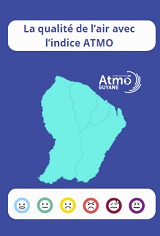Blada.com
vendredi 12 décembre
Boîtes aux lettres
Courrier des lecteurs
Petites annonces
Emploi / Formation
Covoiturage
Infos citoyennes
Infos citoyennes
29/11/19
Colloque : le territoire de l'Inini (1930-1969)
 A l’occasion du cinquantenaire de la suppression du territoire de l’Inini, un colloque sera organisé le Samedi 7 décembre 2019, de 9h00 à 16h00 à l’Hôtel de la Collectivité Territoriale.
A l’occasion du cinquantenaire de la suppression du territoire de l’Inini, un colloque sera organisé le Samedi 7 décembre 2019, de 9h00 à 16h00 à l’Hôtel de la Collectivité Territoriale.
Un évènement qui s’inscrit dans le cadre du Rapport d’Orientation Budgétaire 2019 et dans la programmation culturelle 2019 de la Collectivité Territoriale de Guyane, au titre des commémorations territoriales, s’agissant du cinquantenaire de la suppression du Territoire de l’Inini.
Ce colloque répond aux missions scientifiques des Directions des Archives Territoriales de Guyane et du Musée des Patrimoines.
Des recherches seront présentées lors de ce colloque, participant à la connaissance et la valorisation des communes de Guyane, le Territoire de l’Inini ayant entraîné la création des communes de l’intérieur et la reconfiguration des autres communes, ainsi que l’entrée en citoyenneté française des populations amérindiennes et bushinengués.
Le 6 juin 1930 est créé en Guyane le territoire autonome de l’Inini. La colonie de la Guyane se retrouve administrativement coupée en deux parties très inégales :
- une mince bande littorale, qui garde son statut de colonie, administrée par le gouverneur puis le préfet et ses services, par le conseil général et les communes (1/5e du territoire);
- une très large partie intérieure, administrée directement par le gouverneur, chef de la colonie de la Guyane française, puis par le préfet (4/5e du territoire).
Cette grande partie du territoire est celle où se situent la majorité des sites miniers et forestiers et surtout les villages amérindiens et businenge des Wayana, Wayapi, Teko, Paramaka, Ndjuka, Aluku. Des campements et villages se sont créés avec l’exploitation de l’or, du bois de rose et du balata, dans lesquels affluent, notamment, des Guyanais créoles, des bagnards libérés et de nombreux étrangers venus de la Caraïbe anglophone.
Le Territoire de l’Inini est le lieu également de l’implantation d’établissements pénitentiaires spéciaux à destination des condamnés venus de la colonie française d’Indochine, main d’œuvre utilisée pour de grands projets de désenclavement.
Ce territoire, spécifique à la Guyane, perdure jusqu’en 1969. Sa suppression entraîne la reconfiguration administrative complète du territoire, la création de nouvelles communes (Maripasoula, Camopi, Saül, Saint-Elie, Grand-Santi-Papaïchton), la modification importante des communes existantes sur le littoral et l’entrée dans la citoyenneté française des populations amérindiennes et businenge.
Au programme de cette journée :
9 h 00 : Accueil des participants
9 h 30 : Allocution d'ouverture : M. Rodolphe Alexandre, président de la Collectivité territoriale de Guyane
10 h : 1ère séance (modérateur : Kristen Sarge)
- Georges RECH : "Une expérience d'archivistique reconstructrice : le classement du fonds de l'Inini aux Archives territoriales de Guyane"
- Rémy PERU DUMESNIL : "Le territoire de l’Inini : une création héritée du second empire colonial français en Afrique ?"
- Philippe GUYOT : "Les voyages forment la jeunesse : Jacques Perret en Inini dans le cadre de la mission Monteux-Richard, 1930-1931 ".
11 h 30 : 2ème séance (modératrice : Linda Amiri)
- Michèle-Baj STROBEL : "Les gens de l'or en Inini"
- Kristen SARGE : "Dans les pas des apôtres des chercheurs d’or, agents du Territoire de l’Inini : peuplement, cartographie et développement urbain entre Approuague et Maroni (1932-1969)"
- Tristan BELLARDIE : "Maripasoula, du cercle municipal à la commune : histoire d’une utopie devenue réalité"
- Jean-Maurice MONTOUTE : "Les créoles de l'Inini"
14 h 30 : 3ème séance (modérateur : Georges Rech)
- Christèle DEDEBANT : "Les Etablissements pénitentiaires spéciaux : une politique de grands travaux à demi-réussie"
- Linda AMIRI : "L’Inini, un «far west» pour la population pénale du Territoire pénitentiaire du Maroni ?"
- Pierre GRENAND : "L'Inini et les Amérindiens"
16 h 00 : Synthèse des travaux
On the occasion of the fiftieth anniversary of the suppression of the territory of Inini, a conference will be organized on Saturday, December 7, 2019, from 9:00 to 16:00 at the Hotel of the Territorial Collective.
An event that falls within the framework of the 2019 Budget Orientation Report and the 2019 cultural programming of the Territorial Collective of Guyana, in the name of territorial commemorations, concerning the fiftieth anniversary of the suppression of the Inini Territory.
This conference responds to the scientific missions of the French Guiana Territorial Archives and the Heritage Museum.
Research will be presented during this conference, participating in the knowledge and valorization of the communes of Guyana, the Inini Territory having led to the creation of the municipalities of the interior and the reconfiguration of other municipalities, as well as the entry into French citizenship of Amerindian and Bushinengue populations.
June 6, 1930 is created in French Guiana the autonomous territory of Inini. The colony of Guyana finds itself administratively cut in two very unequal parts:
- a thin strip of coastline, which retains its status as a colony, administered by the governor and then the prefect and his services, by the general council and the communes (1 / 5th of the territory);
- a very large interior part, administered directly by the governor, chief of the colony of French Guiana, then by the prefect (4 / 5th of the territory).
This large part of the territory is where most of the mining and forestry sites are located, and especially the Amerindian and businenge villages of the Wayana, Wayapi, Teko, Paramaka, Ndjuka and Aluku. Camps and villages were created with the exploitation of gold, rosewood and balata, in which tributaries, in particular, Guyanese Creole, released convicts and many foreigners from the English-speaking Caribbean. The Territory of Inini is also the place of the establishment of special penitentiary institutions for convicts from the French colony of Indochina, labor used for major projects opening up.
This territory, specific to Guyana, lasted until 1969. Its suppression entails the complete administrative reconfiguration of the territory, the creation of new municipalities (Maripasoula, Camopi, Saul, Saint-Elie, Grand-Santi-Papaïchton), the important modification existing municipalities on the coast and the entry into French citizenship of the Amerindian and businenge populations.
In the program of this day:
9:00 am: Welcome of the participants
9.30 am : Opening address: Mr. Rodolphe Alexandre, President of the French Guiana Territorial Collective
10 am : 1st meeting (moderator: Kristen Sarge)
- Georges Rech: "A reconstructive archival experience: the classification of the Inini fonds in the French Guiana territorial archives"
- Rémy PERU DUMESNIL: "The territory of Inini: a creation inherited from the second French colonial empire in Africa?"
- Philippe GUYOT: "Travels form youth: Jacques Perret in Inini as part of the Monteux-Richard mission, 1930-1931".
11:30 am : 2nd meeting (moderator: Linda Amiri)
- Michèle-Baj STROBEL: "The people of gold in Inini"
- Kristen SARGE: "In the footsteps of the apostles of the gold prospectors, agents of the Inini Territory: settlement, cartography and urban development between Approuague and Maroni (1932-1969)"
- Tristan BELLARDIE: "Maripasoula, from the municipal circle to the commune: history of a utopia become reality"
- Jean-Maurice MONTOUTE: "The Creoles of Inini"
2.30 pm : 3rd meeting (moderator: Georges Rech)
- Christèle DEDEBANT: "Special Prison Facilities: a policy of major works to half-successful"
- Linda AMIRI: "The Inini, a" far west "for the criminal population of the Penitentiary Territory of Maroni?"
- Pierre GRENAND: "The Inini and the Amerindians"
4:00 pm: Summary of work
Raccourcis


passer une petite annonce

passer une annonce de covoiturage


passer une annonce d’emploi







associations, postez vos actualités

participez au courrier des lecteurs
La Guyane c’est ici
La qualité de l’Air avec
ATMO
Photothèque

Lancements 2022
Vol 259 Ariane 5




